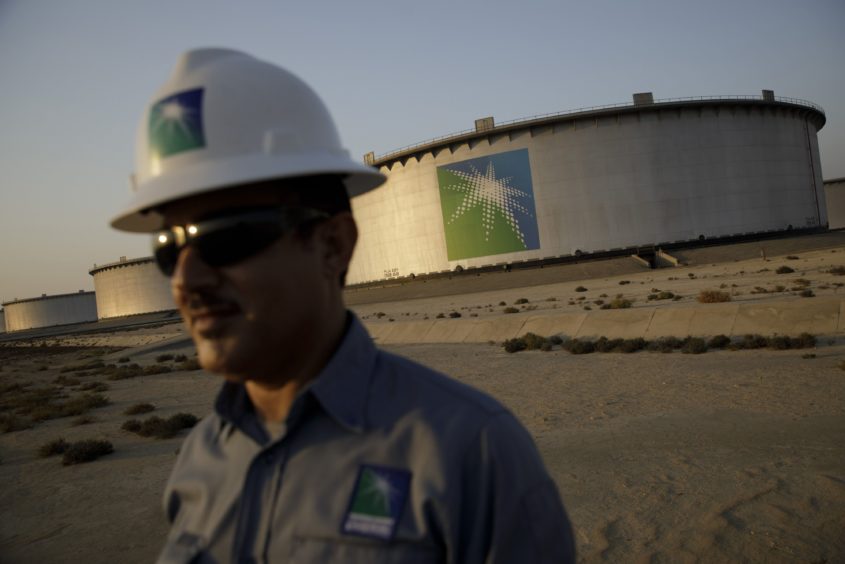
Saudi Aramco showed Monday it’s still the world’s most profitable company — and paid out almost all its net income in dividends — despite the dwindling price of oil.
Profit slid 12% to $46.9 billion in the first six months of 2019, the state-owned energy giant said in its first-ever half-year earnings report. That easily outstripped corporate titans such as Apple Inc., Amazon.com Inc. and other big oil producers, many of which suffered larger declines in profit as output and crude prices fell.
“We have some of the largest and most productive reservoirs on Earth,” Khalid Al-Dabbagh, senior vice president for finance, strategy and development, said in an interview. The company’s “unrivaled financial results” amid lower oil prices are “a testament to our resilience.”
Aramco paid out $46.4 billion in dividends in the first half. That included a $20 billion special payout to its owner — the Saudi government — which compares with a $6 billion payout last year. That’s of particular interest to potential investors ahead of an initial public offering planned for 2020 or 2021, though it may not be maintained, according to money manager T. Rowe Price Group Inc.
“We still don’t really have clarity on the dividend policy,” Willem Visser, a credit strategist at T. Rowe Price, said after Aramco held its first-ever earnings call. Looking ahead, “it will probably be in line with other oil companies at about 50% of net income.”
Aramco, officially known as Saudi Arabian Oil Co., published annual financial statements for the first time in April, ahead of a $12 billion bond sale. It’s now preparing for what could be a record IPO, putting the Damman-based company under even greater scrutiny from investors and inviting comparisons with other oil majors.
The average selling price for Aramco’s crude fell to $66 a barrel in the first half from $69 a year earlier, while crude production held steady at 10 million barrels of oil equivalent a day. Unlike most other energy companies, Aramco’s output is controlled by the state — the world’s biggest oil exporter — and the hefty royalties and taxes it pays underpin the Saudi economy.
Although the kingdom’s dependence on Aramco places a heavy burden on the company’s cash, its free cash flow increased almost 7% to $38 billion as a result of working-capital movements and lower capital spending.
“This all results in the best financial performance that any investors — whether debt or equity — would look for when evaluating a company,” Al-Dabbagh said. “The company is ready for an IPO,” he said, reiterating that the decision on when to go ahead, and on which exchange, rests with the government.
Saudi Arabia wants to raise a record $100 billion from selling a 5% stake in Aramco, which would make it the biggest IPO in history and a windfall for any banks that win a role. The kingdom has valued the company at a whopping $2 trillion, though the firm’s 2018 financials indicated a valuation closer to $1.2 trillion.
Acquisition Plans
Saudi Arabia announced plans for an Aramco IPO three years ago, but the sale was delayed to allow the company to acquire chemicals giant Saudi Basic Industries Corp. Aramco sold bonds to buy a 70% stake in Sabic from the kingdom’s sovereign wealth fund. And it showed Monday that’s it’s not done yet with acquisitions.
Aramco plans to buy a stake in the refining and chemicals business of India’s Reliance Industries Ltd. as it seeks buyers for its crude and diversification downstream.
Aramco will acquire a 20% stake in the company’s oil-to-chemicals business, including the 1.24 million-barrel-a-day Jamnagar refining complex on India’s west coast, Reliance Chairman Mukesh Ambani said in Mumbai. Reliance values its oil-to-chemicals division at $75 billion including debt, implying a $15 billion valuation for the stake.
“Aramco has a long-running policy of expanding in major consumer markets in downstream to secure its crude market share,” said Okan Akin, a credit analyst at AllianceBernstein Ltd. in London. “This deal would also make a lot of geopolitical sense for the Saudis, as it will likely allow them to overtake Iran as the main crude supplier” to India.
The deal comes amid ambitious plans by Saudi Crown Prince Mohammed bin Salman, who runs the country day to day, to move the economy away from its reliance on oil sales. Saudi Arabia is getting a makeover under the prince, who assumed his de facto leadership in 2017 vowing to steer the kingdom from its near-total dependence on crude by masterminding reforms known as Vision 2030.
Recommended for you
